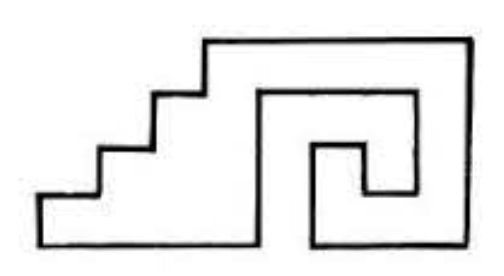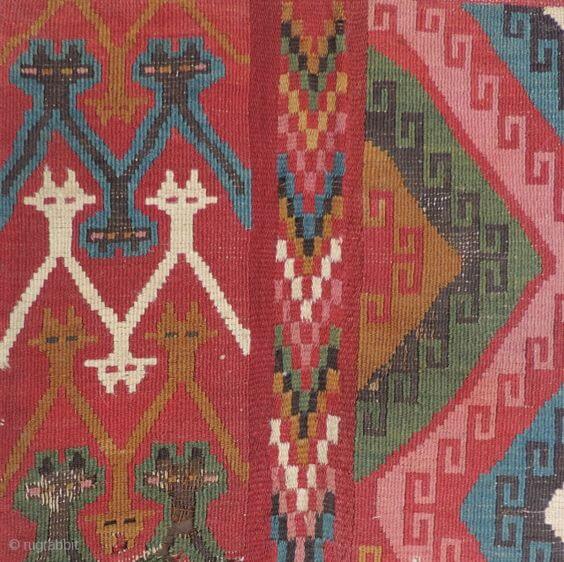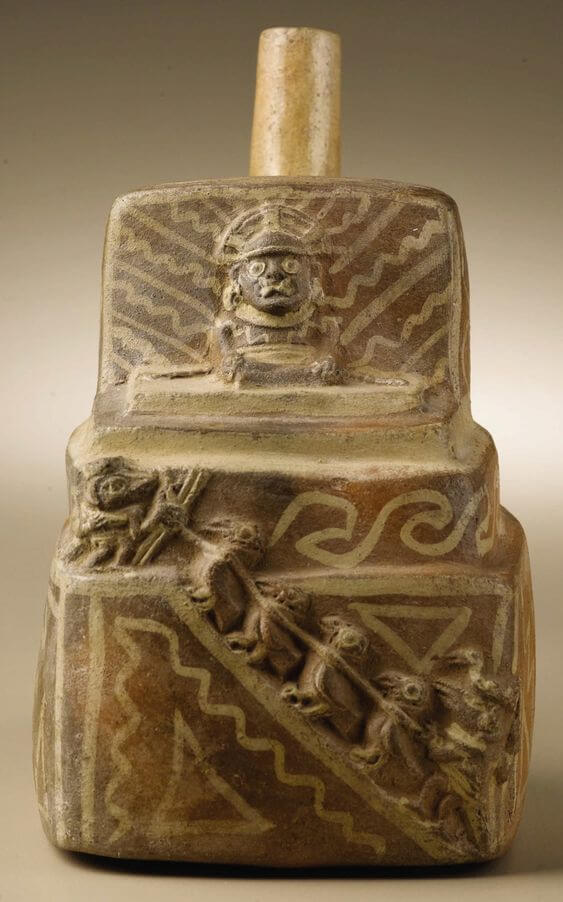Why is the Step Meander (Meandro Escalonado) so important?
Find out in this article
by Belén Cuadros | 20 September 2022
Pre-Hispanic iconography is full of symbolism that helps us understand the vision of the ancient Peruvians. Kauffmann Doing, Peruvian anthropologist, archaeologist and historian, provided the key to identify and understand magical-religious signs of special hierarchy and whose presence in Andean iconography is reflected throughout the development of Peruvian societies. Starting in Chavín de Huántar until the end of the Inca Empire, and why not, until today.
Today we will focus on this:

This is the famous MEANDRO ESCALONADO
This symbol helps us understand the way the ancient Peruvians looked at the world. Societies that lived in permanent crisis to produce enough food to survive and that, in turn, were exposed to the changes of mother nature.
Let’s understand this symbol separately.

We see two equally important signs.
EARTH GODDESS-PACHAMAMA
In this Nasca bag we can appreciate the staggered shape.

CHILEAN MUSEUM OF PRE-COLUMBIAN ART (S/F) Nasca Bag. 100-700 d.C.
According to Kauffmann, the staggered sign refers to the terraces or cultivation terraces that were decorated to honor the Earth Goddess or Pachamama.

GOD OF WATER
In this Chancay mantle we can find the sign of water as a wave composed of more elements, however, the form is maintained.

The baton shape is assumed to be inspired by the image generated by the crest of a wave.

FERTILITY
If we join both symbols, we have a figure that refers to fertility and a clear relationship to the natural cycle of water.

SEE DIFFERENT EXAMPLES




In conclusion, as Uwe Carslon says in his book Andean Iconography: Interpretation of Symbolism in Ancient Peruvian Textiles:
“It should not and cannot be intended to deal with this issue in depth, that is, to clarify the iconography of the ancient Peruvian peoples, since there are still many pending questions. However, it is possible to get considerably closer to that elementary world of expressions, which is largely assumed religiously. This is even more so, since these cultures did not have fixed rules to represent their divinities.” CARLSON, Uwe (2012)
I invite you to investigate more on the subject. I leave you the sources where I got the information so you can learn in greater depth about theMEANDRO ESCALONADO.
Did you know this?
Love,
Belén Cuadros
Bibliografía:
CARLSON, Uwe (2012) Iconografía Andina: Interpretación del simbolismo en antiguos tejidos peruanos.
CARLSON, Uwe (s/f) Emblemática Moche: La imagen divinizada
Imágenes:
CARLSON, Uwe (2012) Iconografía Andina: Interpretación del simbolismo en antiguos tejidos peruanos.
CARLSON, Uwe (s/f) Emblemática Moche: La imagen divinizada.
MUSEO CHILENO DE ARTE PRECOLOMBINO(S/F) Bolsa Nasca. 100-700 d.C. (http://precolombino.cl/en/sala-textil/bolsa/)
ABRECHTGROUP.COM(S/F) Los Andesnes del Camino Inca (https://abrecht-group.com/2019/07/29/los-andenes-del-camino-inca/)
ARTS INSTITUTE CHICAGO (S/F) Mantle Corners. Chancay. Central Coast, Perú. 1000-1476 d.C. (https://www.artic.edu/artworks/85405/mantle-corners)
COLLINS, Ray (s/f) En la cresta de la ola. Obtenida de (https://www.metro951.com/2015/04/en-la-cresta-de-la-ola/entretenimiento/)
BRGFX(s/f) Water cycle process on earth (https://www.freepik.com/free-vector/water-cycle-process-earth_5135339.htm?epik=dj0yJnU9Y2Z0VkREY0JQRjdldEtEbVl1VHgzTXJxWnBYTE1DNVAmcD0wJm49a09YYy1SeTNVNjUtakxqWldLck1ZQSZ0PUFBQUFBR0x6M1V3)
RUGRABBIT (S/F) Pre-Columbian Tapestry Textile. (https://rugrabbit.com/node/184692)
SOTHEBYS.COM (S/F) Wari Figural Vessel in Black and White Tunic ca. A.D. 600-1000 (http://www.sothebys.com/en/auctions/ecatalogue/2014/african-oceanic-n09146/lot.203.html)
LOMAN, Bernad (S/f)( https://www.pinterest.es/pin/575968239854782441/)
ARTS INSTITUTE CHICAGO (S/F) Feathered Chimú tunic. (https://www.artic.edu/artworks/85533/feathered-tunic)